OCS analysis of proposed "debate template"
(Note: I am posting a webified version of the Ohio Citizens for Science analysis of the new “son of critical analysis” proposal, a “debate template” which may come up for a vote tomorrow. The original PDF is available at the OCS website, but a web version may reach more readers and show up better in google. Particularly interesting in the OCS analysis are the graphics of the early versions of the lesson plan which originally became the famed (now defunct) “Critical Analysis of Evolution” lesson. Examination shows that the creationists in Ohio have been thinking of framing evolution as a “debate” or “trial” from the very beginning. If you pay attention to such things this is creationist “contrived dualism” going back to the 1980s and probably before – notably, the “Two Model Approach” advocated by the creation scientists and debunked in_McLean_and_Edwards.)_
Ohio Citizens for Science Call for Action on Resolution 31 and Response to the Proposed Framework for Teaching Controversial Issues aka “Controversy Template”
Contacts: Steve Rissing 614-791-0153 Patricia Princehouse 440-478-5292
Ohio Citizens for Science urges the Ohio Board of Education to accomplish the following at its meeting scheduled for 11-12 September 2006:
* Achievement Committee co-Chair Mr. Jim Craig or Rev. Michael Cochran must call the question directed to the attention of the Committee by the entire Board in February 2006 in Resolution 31 –the Board’s decision to remove “Critical Analysis of Evolution” language from Ohio’s Academic Standards. The Board charged the Achievement Committee to “consider whether the deleted model lesson, Benchmark H, and Indicator should be replaced by a different model lesson, benchmark and indicator, and if so, to present any recommendation to the entire State Board for adoption.”
* If the Achievement Committee continues to ignore this charge at its Monday Sept 11 meeting, then the Board should recall this responsibility from the Achievement Committee, and the entire Board should vote at its Tuesday Sept 12 meeting that replacement language is NOT required.
* However many times and in whatever form the Controversy Template may be re-introduced after the above-mentioned vote, the Achievement Committee and/or Board should reject it for the following reasons.
Executive Summary:
The Ohio Board of Education’s proposed Controversy Template is incoherent if, as its major proponent has stated, it will have teachers and students “challenge everything.” It is impossible to challenge everything in each school class; to even attempt such a thing would result in chaos and no learning. Clearly the template is in fact the latest step in ongoing efforts to orchestrate a religiously motivated attack on the theory of evolution (as detailed below). That explains why its content was kept secret as long as possible. While science relies constantly on genuine critical analysis, it does not use denigrating debate tools based on political propaganda and ill-informed by evidence. The Board must call the question and vote down this transparent ploy.
Critical Analysis of the Framework for Teaching Controversial Issues
After repeated denials of its existence and only under repeated exercises of Ohio’s Public Documents law, the Ohio Department of Education has released a draft of its “Controversial Issues Framework” also referred to as a “Controversial Issues Template,” called hereafter, Controversy Template.
The proposal seems innocuous upon first reading by someone unfamiliar with its context, history, and proponents. Given that the proposal will be discussed and possibly voted on by the Board’s Achievement Committee on Monday 11 September 2006i, Ohio Citizens for Science provides here an initial evaluation of the proposal. We also try to provide some of the history of this ongoing effort and the issues contained therein.
The proposal begins by stating: “Students learn valuable skills when they research and discuss controversial issues.” (p. 1.) Why not do this? We start our analysis there.
What’s wrong with this Controversy Template?
1. A recent statement by one of the proposal’s chief supporters on the Board illustrates the supposed reach of this proposal:
“Board member Debra Owens Fink said today that the proposal isn’t a challenge to evolution, but rather is a challenge to everything. Teachers will be encouraged to have debates on all controversial topicsii.” (Emphasis added)
a. This is nonsense because no guidance is provided to, or apparently by, classroom teachers regarding the range of topics considered appropriate for student research and discussion.
b. An earlier draft of this proposal obtained through a Public Request for Records reveals, however, one of the intended target issues of the effort:
“Discuss and be able to apply this in the following areas:
Earth and Space: a.) Global warming,
Life Sciences: a.) Evolutionary Theory
Science and Technology: a.) Emerging technologies and how they may impact society, eg cloning or stem cell research”iii,iv
2. In an e-mail dated 27 June 2006 and accompanying the draft to Board member Carl Wick, Board member Deborah Owens-Fink made the following statements:
a. “Carl- thank you for your continued interest in the evolution issue-“
b. “my preference would be to elevate this to a benchmark- not just a standard-as the benchmarks are what is by statute to be tested.”
c. “One proposal for operationalizing this is to not have a specific model curriculum, but rather to develop a template …rather than a specific lesson on…evolution”
d. In making this last point, Owens-Fink acknowledges that the current proposal is an effort to reinstate the Model lesson removed by the Board at its February 2006 meeting and an extension of her efforts since 2000 to insert Intelligent Design Creationism into Ohio’s public school curriculum.v
3. The links to “intelligent-design” creationism are clear:
a. On March 11, 2002, Discovery Institute Fellow Stephen Meyer introduced the terminology “teach the controversy” in a presentation to the Ohio Board of Education as a alternative way to deal with creationist thought leaders’ calls for teaching “intelligent-design.” The terminology “teach the controversy” has been equated to Ohio’s “critical analysis.” Judge Jones addressed the issue of teaching the controversy in the Dover trial as “at best disingenuous.” It is but a small step from “teach the controversy” to “teaching controversial issues,” to the [Teach the] Controversy Template. The terminology “critical analysis” appears in the Controversy Template as its major motivation, even though achievement committee members, including Cochran and O-F, stated earlier this year that the term “critical analysis” had acquired too much “baggage” and should not be used.
b. If this is not about “intelligent-design” creationism, why is John West of the Discovery Institute commenting on it in so familiar a fashion? How (and when) did he get a copy?
4. The Controversy Template contains only one topic in science actually suggested for treatment as a Controversial Issue –the nature of science itself. Specifically, the heart of the entire “intelligent-design” debate as trumpeted by groups such as Intelligent Design Network is over the fact that science is limited to natural explanations for natural phenomena. Science cannot comment one way or the other about the supernatural, and thus excludes consideration of supernatural explanations. Most scientists and clergy have no problem with that, nor does the US Constitution. Attempts to violate the nature of science make for bad science, and bad science education. Confusing students about the nature of science is a standard creationist strategy to use the science classroom as a religious conversion opportunity.
Why now?
1. In February 2006 the Board responded to the Dover, PA court decision that found “Intelligent-Design” Creationism to be religious indoctrination by removing Ohio’s standards and sanctioned curriculum language that encouraged similar presentations of creationist material and misrepresentations of evolutionary theory in Ohio.
2. Board members Rev. Cochran, Ms. Grady, Dr. Owens-Fink and Ms. Westendorf argued in favor of retaining Ohio’s anti-evolution language and were the sole opponents to this “Resolution 31.”
3. The Board approved an amendment to Res. 31 that stated “The Achievement Committee of the State Board of Education is charged to consider whether the deleted model lesson, Benchmark H, and Indicator should be replaced by a different model lesson, benchmark and indicator, and if so, to present any recommendation to the entire State Board for adoption.” Board member Owens-Fink was the sole nay vote.
4. The Achievement Committee, co-chaired by Rev. Cochran, has never taken a vote to make the above determination.
5. All discussions of the Controversy Template by the Achievement Committee since the February meeting have been labeled “discussion of Res. 31” in agendae and minutes.
6. A reasonable person must conclude that the Committee’s discussion of the Controversy Template constitutes its replacement language for pro-Intelligent Design Creationism language removed by the Board in February without any vote by the Achievement Committee that such replacement language was needed.
7. The conclusion by Judge John Jones III in his Dover, PA decision applies equally well here: “students, parents, and teachers…deserved better than to be dragged into this legal maelstrom, with its resulting utter waste of monetary and personal resources.”
Why not encourage debate?
1. Debates have a place in the political arena (two political debate websites are referenced in the draft proposal document; see its footnotes 19 and 20); political debate is irrelevant to scientific endeavors and in science education.
2. Documents released last year by ODE in response to a Public Documents Request by Americans United for the Separation of Church and State reveal that the current Controversy Template Proposal is just the next in a long line of efforts by these same Board members to force Ohio’s teachers and students to engage in a debate between evolutionary theory and creationism. Of the “Critical Analysis of Evolution” model lesson removed by the Board in February and referred back to the Achievement Committee for possible replacement language, we already know: The Model Lesson was also a debate format; early versions were variously titled “Great Evolution Debate,” “Evolution on trial”, etc.
(NOTE: IN THE IMAGES BELOW, ALL TEXT AND ACCOMPANYING HAND WRITTEN NOTES ARE SCANS OF PUBLIC DOCUMENTS RELEASED BY ODE IN RESPONSE TO A PUBLIC RECORDS REQUEST BY AMERICANS UNITED FOR THE SEPARATION OF CHURCH AND STATE. WRITTEN COMMENTS WERE MADE BY ODE STAFF SPECIALISTS PRIOR TO COPYING AND RELEASE BY ODE.):
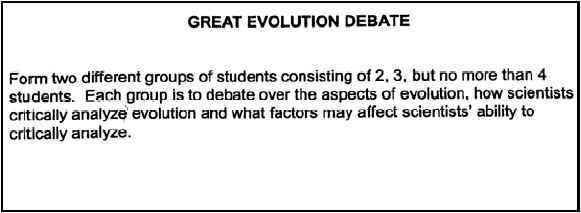
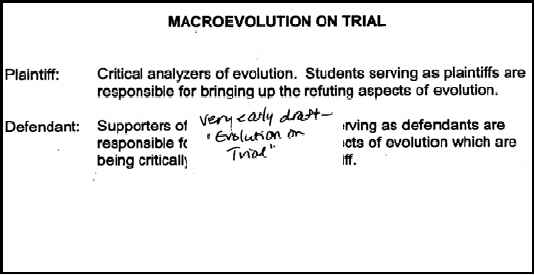
a. Outside reviews of the lesson chosen by ODE explicitly condemned the debate format (and most other aspects) of the lesson; most of these criticisms were kept from most Board members. Relevant excerpts of outside reviews released by ODE include the following:


b. ODE’s own educational staff experts opposed the debate nature of the earlier lesson, the one the proposed template replaces with yet another effort to incite debate. The same criticisms apply to the template, thus is seems likely the ODE staff is likely once again being silenced by some members of the Board. Consider the following documents with marginal comments released by ODE one year ago:

The handwritten note says: “We are not drawing lines in the sand.”
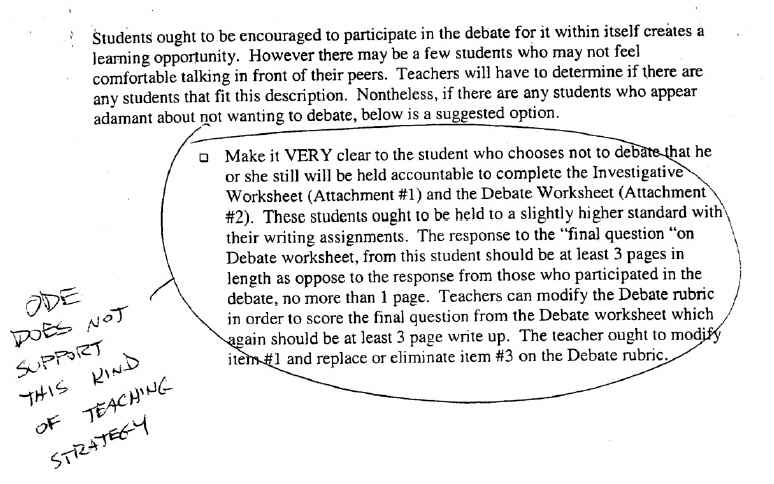
c. The above considerations caused a re-writing of the old, discredited lesson plan rejected by the Board in February. Nonetheless, the author (and at least one other “ghost writer”) clung to the debate format disregarding the pedagogical and scientific criticisms of ODE staff and outside reviewers. Compare an early section of the “debate format” of the lesson:

With the new “critical analysis” format of the lesson (with marginal comment evaluation by ODE staff educational specialists):

The opposition of ODE staff specialists and outside reviewers to the debate (and most other aspects of the “Critical Analysis of Evolution” Model Lesson were concealed from the Board. We have no reason to expect anything has changed with this replacement Template. Indeed, we suspect that the more things change in this effort, the more they stay the same.
Is not “Critical Analysis” part of The Scientific Method?
1. It is in the sense of a careful analysis, but not in the sense of a denigrating analysis. This same confusion, and exploitation of it, was obvious in the development of the old “Critical Analysis of Evolution” Model Lesson, and there is no reason to suspect any different outcome this time. The following demonstrate the extent of the confusion over this concept in the previous efforts; most of this information has to date been concealed from most of the Board and the public.
2. ODE staff complained that the author of the lesson (Leonard), himself, did not understand the scientific usage of Critical Analysis:

The ODE staff comment reads: “+ CRITICAL ANALYSIS–because teachers & students must understand indicator’s meaning (Leonard does not)” (emphasis added)
3. The ODE staff generated the official, Ohio definition of the concept of “Critical Analysis” as used in its Model Lesson (and now in the new Controversy Template) through the following three step process:
a. Step One: Consult the High-school Homework Help website and find a definition for the word “Critical”:
[large image cut, which is just a printout of the dictionary.com definition of “critical”]
b. Step Two: Repeat the process for the word “Analysis”:
[large image cut, which is just a printout of the dictionary.com definition of “analysis”]
c. Step Three: Write a report establishing the definition of “Critical Analysis” by joining the definition of the two separate terms:

4. This effort, however, drew the ire of at least one ODE senior staff specialist who “went on record” to complain of the definition that was “glommed together” and “inadequate for the purpose of science”:
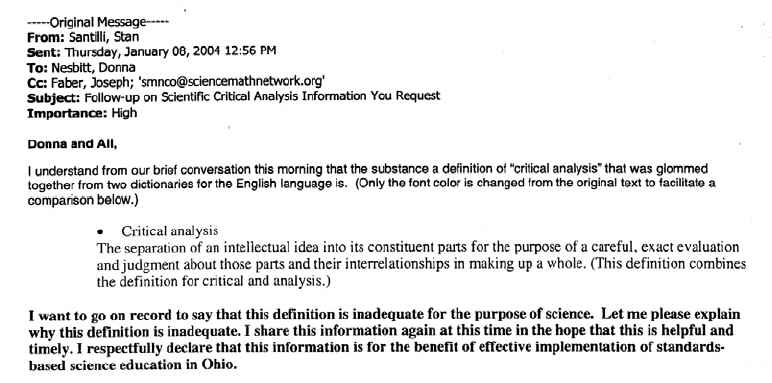
5. It was clear that creationist thought leaders on the Board were focusing specifically on evolution:
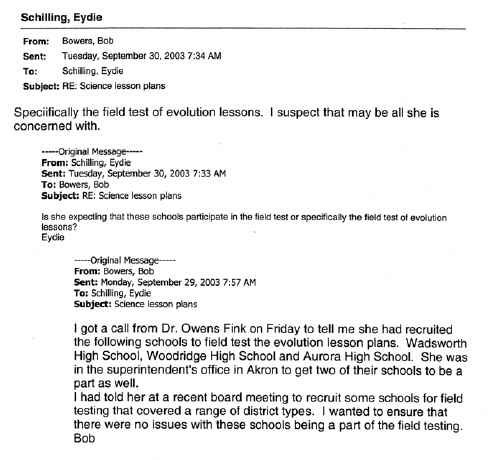
6. When the nature of these and many other complaints finally came to the attention of some members of the Board in early 2006, they promptly and responsibly removed the lesson and the standards language calling for it. The current Controversy Template is just another in a very long series of attempts to introduce “Intelligent-Design” red-herrings into Ohio’s Curriculum and Standards.
What about critically analyzing evolutionary theory like all other theories?
1. It is. Constantly. On a daily basis. Some OCS members actively design and carry out experiments to challenge evolutionary theory and aspects of it such as the levels of a population at which natural selection works.
2. The ODE staff analysis of the earlier “Critical Analysis of Evolution” Model Lesson reveals the inherent misrepresentations of evolution favored by the same outspoken members of the Board that insisted on and participated in the preparation of the lesson and the current Controversy Template. For example:
a. An early version of the Critical Analysis lesson read: “Additionally, a growing number of scientists now doubt that Archaeopteryx and other alleged transitional fossils really are transitional forms.”
b. Of this sentence, ODE’s own staff science consultant said: “The underlined sentence is a lie.”
c. The accepted version of the above sentence became: “A growing number of scientists now question that Archaeopteryx and other transitional fossils really are transitional forms.” It’s still a lie.
d. Dr. Bobby Bowers, Deputy Superintendent, described this process that permitted numerous examples like the above by answering a question from Board member Robin Hovis (regarding the concerns of sixteen scientific and educational professional organizations that urged rejection of the lesson) by telling the Board: “I think you…would have to say that we have been as responsive as we possibly can be to the legitimate kinds of criticisms.” (8 March 2004.)
3. Similarly regarding the topic of homologies, a common red-herring argument from the creationist literature:
a. An early version of the Critical Analysis lesson stated: “…many times, similar anatomical structures in different animals are built from different genes…”
b. Of this claim, ODE staff scientists said: ““…inaccurate …Similar structures in closely related organisms are always controlled by the same genes, no exceptions.” (emphasis added)
c. The final version of the lesson brought by the ODE to the Board for approval read: “…sometimes, similar anatomical structures in different animals are built from different genes…”
-
ODE staffers prepared entire analyses of the earlier Critical Analysis lesson describing in detail the degree to which it was based upon unsupportable, invalid, and outright false “Intelligent-Design” Creationist arguments, yet these documents were never presented to Board members.
-
This history calls into question the motivations and impartiality of major players in the process and causes the Ohio Citizens for Science to oppose the current Controversy Template for reasons related to its context as well as its content.
_______________________________________________
(Notes)
i www.ode.state.oh.us/GD/Templates/Pages/ODE/ODEDetail.aspx?page=3&TopicRelatio nID=576&Content=15871
ii “New state school board proposal draws national scrutiny” Akron Beacon-Journal, 6 September 2006 (www.ohio.com/mld/ohio/news/15453256.htm)
iii The paper copy of this proposal presented by Board member Colleen Grady to the Achievement Committee in its meeting of 10 July contained all of this wording except that the phrase “stem cell research” had been removed with “white out” leaving a blank where it had been on the photocopy original; an earlier version listed “evolutionary theory, global warming and the chemical origin of life”; the draft minutes describing Grady’s proposal list evolutionary theory, global warming, cloning, and stem cell research.
iv This earlier draft of the proposal contains the electronic signature of Board member Deborah Owens-Fink.
v On March 7, 2000, Board member Deborah Owens-Fink proposed altering the Ohio curriculum to teach “intelligent design.”
